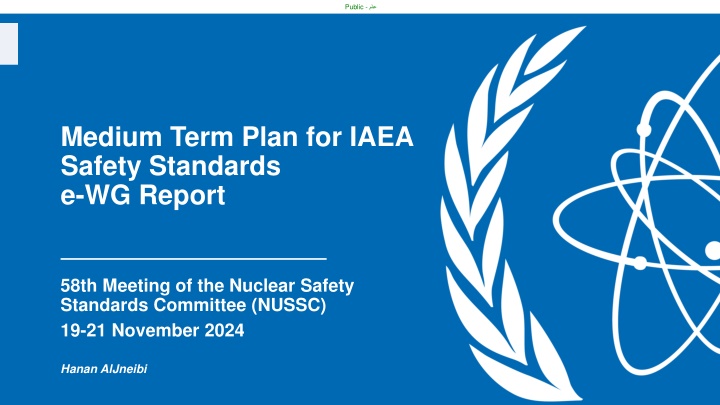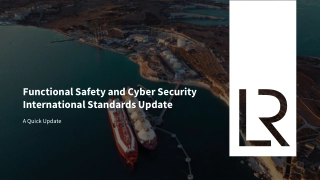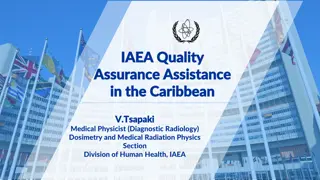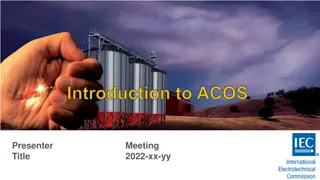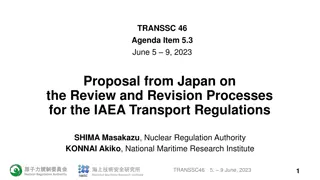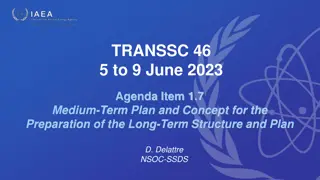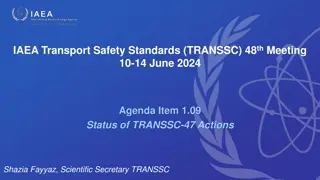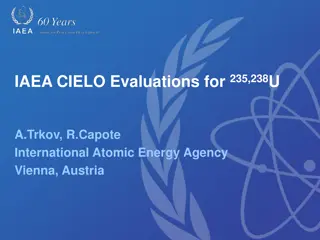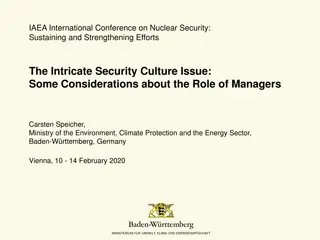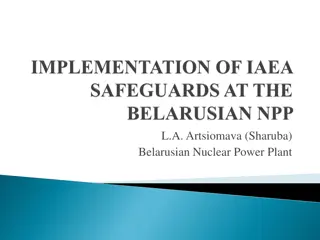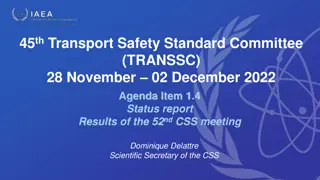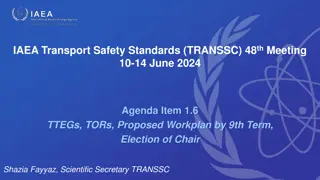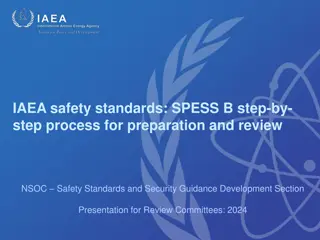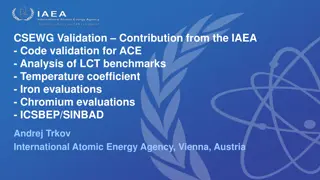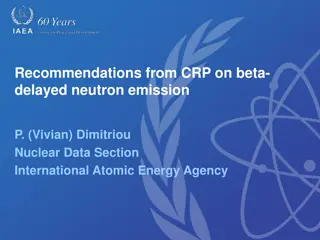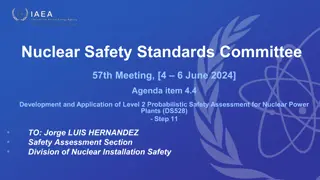Medium-Term Plan for IAEA Safety Standards e-WG Report
During the 58th Meeting of the Nuclear Safety Standards Committee, discussions centered around the Medium-Term Plan for IAEA Safety Standards. Insights from surveys and responses were analyzed to guide safety standards development. The proposed draft report delves into updating safety standards, specific recommended revisions, emerging technologies, and future considerations. Recommendations and conclusions were drawn based on the survey findings to enhance nuclear safety standards.
Download Presentation

Please find below an Image/Link to download the presentation.
The content on the website is provided AS IS for your information and personal use only. It may not be sold, licensed, or shared on other websites without obtaining consent from the author.If you encounter any issues during the download, it is possible that the publisher has removed the file from their server.
You are allowed to download the files provided on this website for personal or commercial use, subject to the condition that they are used lawfully. All files are the property of their respective owners.
The content on the website is provided AS IS for your information and personal use only. It may not be sold, licensed, or shared on other websites without obtaining consent from the author.
E N D
Presentation Transcript
Public - Medium Term Plan for IAEA Safety Standards e-WG Report 58th Meeting of the Nuclear Safety Standards Committee (NUSSC) 19-21 November 2024 Hanan AlJneibi
Public - Background/Summery During its 57thmeeting in Jun 2024, NUSSC decided to proceed with the development of the NUSSC living Medium-Term Plan. Inputs from the Medium-Term Plan were collected through consultations with respective Member States. The new Medium-Term Plan will guide the developing Safety Standards over the next five years, incorporating inputs from review committees and IAEA Member States. NUSSC established an e-Working Group (e-WG) to design a survey questionnaire, which was available to NUSSC members from July 19thto October 15th, 2024 and received a total of 31 responses. The NUSSC e-WG analysed the survey responses, complied a draft report, and develop a comprehensive summary.
Public - Structure of the Report (draft) 1. Executive Summary Overview of Survey Objectives Summary of Recommendations 2. Introduction Background on IAEA Safety Standards Purpose and Scope of the Survey Methodology and Data Collection 3. Survey Response Rate and Completeness 4. Detailed Analysis of Responses Question 2: Need for Updating Safety Standards Question 3: Specific Standards Recommended for Revision 5. Emerging Technologies and Future Considerations 6. New Topics Suggested for IAEA Safety Standards 7. Recommendations 8. Conclusion 9. Appendices Appendix A: Complete Survey Questionnaire Appendix B: Raw Survey Data Summary (e.g., response frequencies, key comments) Appendix C: List of Responding Countries and Organizations
Public - Survey Response Rate and Completeness Total Responses received: 31 Duration: July 19 - October 15, 2024
Public - Question 2: The Need for Updating Safety Standards Do IAEA Safety Standards require updating to reflect technological advancements and new Safety concerns / challenges (other than those already being revised)? YES 85.71% NO 14.29% 0% 10% 20% 30% 40% 50% 60% 70% 80% 90% 100%
Public - Specific Standards Recommended for Revision within 5 years Remarks S/N Votes Title (Additional Criteria) (1st Criteria) 1 12 /17 (70.59%) 11/17 (64.71%) 11 /15 (73.33%) 14 /16 (87.50%) 14/16 (87.50%) 14/18 (77.78%) 14 /17 (82.35%) GSR Part 4 (Rev. 1), 2016 - Safety Assessment for Facilities and Activities 2 SSR-2/1 (Rev.1), 2016 - Safety of Nuclear Power Plants: Design 10th Term Priorities 3 GS-G-3.5, 2009 - The Management System for Nuclear Installations 4 SSG-38, 2015 - Construction for Nuclear Installations 5 SSG-35, 2015 - Site Survey and Site Selection for Nuclear Installations 6 SSG-28, 2014 - Commissioning for Nuclear Power Plants 7 SSG-30, 2014 - Safety Classification of Structures, Systems and Components in Nuclear Power Plants
Public - Specific Standards Recommended for Revision within 5 years Remarks S/N Votes Title (Additional Criteria) (1st Criteria) 8 14 /18 (77.78%) SSG-39, 2016 - Design of Instrumentation and Control Systems for Nuclear Power Plants GSR Part 1, 2016 Governmental, Legal and Regulatory Framework for Safety 10GSR Part 2, 2016 - Leadership and Management for Safety 9 7/14 (50.00%) 8/13 (61.54%) 7/12 (58.33%) 7/15 (46.67%) 7/13 (53.85%) 11 GSG-6, 2017 - Communication and consultation with Interested Parties by the Regulatory Body 12 SSG-34, 2016 - Design of Electrical Power Systems for Nuclear Power Plants 13 SSG-21, 2012 Volcanic Hazards in site Evaluation for Nuclear installations
Public - Reasons for Requesting Revision and Key Topics to Address S/N Title Revise for consistency with SSR-2/2 (DS532), that is currently under revision. Safety Standard has not been revised since the latest publication. Update to reflect advancements since the last publication, incorporating latest requirements and guidelines (e.g., risk-informed approaches, siting studies, external events). Enhance applicability to non-reactor facilities and activities. Revise for consistency with SSR-2/2 (DS532), that is currently under revision. Safety Standard has not been revised since the latest publication. Update to reflect advancements since the last publication, incorporating latest requirements and guidelines. 10th Term Priorities. Safety Standard has not been revised since the latest publication. Update to reflect advancements since the last publication, incorporating latest requirements and guidelines. Revise for consistency with SSR-2/2 (DS532), that is currently under revision. Safety standard has not been revised since the latest publication. Update to reflect advancements since the last publication, incorporating latest requirements and guidelines. Recent Siting and Construction experience should be included. Safety Standard has not been revised since the latest publication. Update to reflect advancements since the last publication, incorporating latest requirements and guidelines. Recent Siting and Construction experience should be included. GSR Part 4 (Rev. 1), 2016 - Safety Assessment for Facilities and Activities 1 SSR-2/1 (Rev.1), 2016 - Safety of Nuclear Power Plants: Design 2 GS-G-3.5, 2009 - The Management System for Nuclear Installations 3 SSG-38, 2015 - Construction for Nuclear Installations 4 SSG-35, 2015 - Site Survey and Site Selection for Nuclear Installations 5
Public - Reasons for Requesting Revision and Key Topics to Address S/N Title Safety Standard has not been revised since the latest publication. Update to reflect advancements since the last publication, incorporating latest requirements and guidelines. The aim is to update and expand safety guidance in line with recent technological advancements (SMRs). Enhanced safety and risk management strategies to ensure the continuity of safe operations. Knowledge management (training) and resource management to ensure safety and response readiness. To align with recent updated standards such as GSR Part 2 (Leadership and Management for Safety) and international guidelines (WANO). Safety standard has not been revised since the latest publication. Update to reflect advancements since the last publication, incorporating latest requirements and guidelines. Integration with the new safety standards or international guidance (IEEE or IEC) to provide more comprehensive framework. Revision could address how risk assessment enhancement methodologies have emerged such as probabilistic risk assessment PRA. Update guidance on classifying digital components (Digital I&C systems) and address cyber security risks. Application to new reactor design (SMRs). SSG-28, 2014 - Commissioning for Nuclear Power Plants 6 SSG-30, 2014 - Safety Classification of Structures, Systems and Components in Nuclear Power Plants 7
Public - Reasons for Requesting Revision and Key Topics to Address S/N Title Outdated and need to be updated to reflect latest knowledge. More emphasis on digital I&C. To consider the application of Artificial Intelligence (AI) in the Control System for NPP. In NPP or other nuclear facilities, clear constraints should be given for the use of wireless technology in digital systems. Requirement 23 & 24 discusses that authorization by the regulatory body, including specification of the conditions necessary for safety, shall be a prerequisite for all those facilities and activities. o Guidance for licensing of manufacturers, designers and NDE service providers are missing. New business models and stakeholders. o Advent of advanced plant designs that can be completely fabricated in a factory. Digitalization, AI and machine learning. o Incorporating digital tools and platforms for regulatory processes, such as electronic document management systems, online licensing, and digital inspections, to enhance efficiency and transparency, o Utilizing data analytics and big data to improve decision-making processes, risk assessments, o Applying AI and machine learning for anomaly detection, regulatory compliance checks, and optimizing regulatory workflows, o Using virtual reality and augmented reality for training regulatory and operator staff and simulating emergency scenarios. All hazards approach and risk management. SSG-39, 2016 - Design of Instrumentation and Control Systems for Nuclear Power Plants 8 GSR Part 1, 2016 Governmental, Legal and Regulatory Framework for Safety 9
Public - Reasons for Requesting Revision and Key Topics to Address S/N Title GSR Part 2, 2016 - Leadership and Management for Safety To ensure it aligns with the updated SSGs on the topic. GSG-6, 2017 - Communication and consultation with Interested Parties by the Regulatory Body SSG-34, 2016 - Design of Electrical Power Systems for Nuclear Power Plants Safety Standard has not been revised since the latest publication. The statements below are considered to be rather vague and distance-based screening criteria for hazards related to volcanism should be developed. o The assessment is expected to identify volcanoes in the geographic area that have shown activity in the past 10Ma years. o The most critical hazards related to volcanism affect areas within tens of kilometers of volcanoes. Safety Standard has not been revised since the latest publication. 10 Safety Standard has not been revised since the latest publication. Guidance for how to build a long-term trust and counteract disinformation. 11 Safety Standard has not been revised since the latest publication. Need periodic review and revision from the viewpoint of the latest knowledge. 12 SSG-21, 2012 Volcanic Hazards in site Evaluation for Nuclear installations 13
Public - Question 5: Emerging Technologies and Future Considerations Given current IAEA Safety Standards and those under development, should NUSSC consider the following new topics to integrate guidance on emerging nuclear technologies? NO NEW TOPICS NEED TO BE INCLUDED AS OF NOW 18.52% 5/26 ADVANCED FUEL CYCLES 48.15% 12/26 ARTIFICIAL INTELLIGENCE 70.37% 18/26 ROBOTICS 40.74% 11/26 NEW TRANSPORT VEHICLES 29.63% 8/26 VIRTUAL REALITY 25.93% 7/26 ADVANCED MANUFACTURING TECHNOLOGIES AND 3D PRINTING 48.15% 12/26 APPLICATION OF DRONES FOR SAFETY AND SECURITY 13/26 51.85% ADVANCED SENSORS AND INSTRUMENTATION 33.33% 8/26 BLOCKCHAIN 4/26 14.81% WIRELESS TECHNOLOGY 11/26 44.44% 0% 10% 20% 30% 40% 50% 60% 70% 80% 90% 100%
Public - Question 7: New Topics Suggested for IAEA Safety Standards Given current IAEA Safety Standards and those under development, should NUSSC consider the following new topics to integrate guidance on various safety concerns related to the operating environment? 17/25 CLIMATE IMPACT 69.23% EXTERNAL EVENTS (E.G., ARMED CONFLICTS) 65.38% 16/25 VARIOUS STAKEHOLDERS (E.G. PUBLIC, INDUSTRY, ETC.) 26.92% 6/25 EVOLVING CYBER THREATS 73.08% 18/25 0% 10% 20% 30% 40% 50% 60% 70% 80% 90% 100%
Public - Recommendations for Topics to Consider During the Revision of the Safety Standards in Medium-Term 1. Artificial Intelligence 2. Climate Impact 3. External Events and Evolving Cyber Threats Medium Term Topics
Public - Recommendations for Topics to Consider During the Revision of the Safety Standards in Long-Term 1. Advanced Fuel Cycles 2. Robotics 3. Advanced Manufacturing Technologies and 3D Printing 4. Application of Drones for Safety and Security Long Term Topics
Public - Thank you
